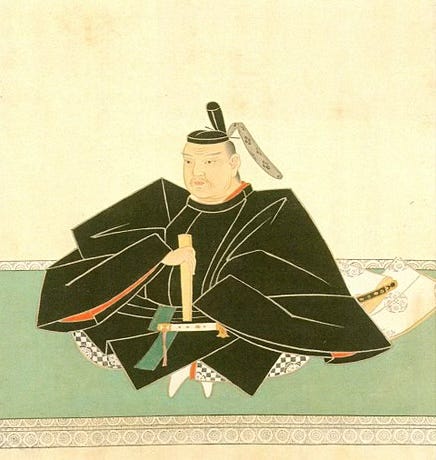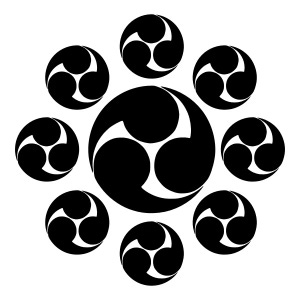Itakura Shigemune
A Samurai In the Service of the Shogun, Front Line Warrior, Statesman, Magistrate and Judge
Itakura Shigemune was a fudai daimyo of the early Edo period, and the first lord of the Shimosa Sekijuku Domain. Born in Sunpu in 1586 as the eldest son of Itakura Katsushige, a close vassal of Tokugawa Ieyasu, as a child Shigemune served as one of Tokugawa Ieyasu’s pages, and was well liked and encouraged by Ieyasu. Shigemune took part in the Battle of Sekigahara in 1600, accompanying Tokugawa Ieyasu’s son, Hidetada along the Nakasendo, seeing action in the siege of Ueda Castle against the Sanada clan. In 1605, he accompanied Tokugawa Ieyasu and Hidetada on their journey to Kyoto to greet the emperor. He served in both the 1614 winter and 1615 summer campaigns of the Siege of Osaka, serving as liaison between Ieyasu and Hidetada, for which he was promoted and given 6,000 koku.
In 1619, it was arranged that Shogun Tokugawa Hidetada's daughter Princess Kazuko would become the consort of Emperor Gomizunoo, but due to the birth of Gomizunoo’s daughter with Princess Yotsuko and the Imperial courts’ displeasure of Hidetada's punishment of the nobles in the Oyotsu Oyashiro Incident, Itakura Shigemune worked together with his father and warlord Todo Takatora mediating the situation, and facilitating Princess Kazuko’s 1620 entry into the Imperial Court.
Itakura Shigemune’s father, Katsushige had served the Tokugawa Shogunate between 1601 and 1620 as the second Kyoto Shoshidai, the deputy Shogun of the Kyoto region. Shigemune inherited his father’s position in 1620 becoming the third Kyoto Shoshidai, a role he held for over 30 years until 1654.
Shoshidai
The Shoshidai was responsible for maintaining relations and open communication between the shogunate and the imperial court. He was in charge of overseeing the collection of taxes, the Imperial court's finances, for ensuring the emperor's personal and the imperial court’s security. The shoshidai controlled a police force of yoriki constables and doushinofficers, as well as a network of undercover spies tasked with discovering and reporting any form of civil or military insurrection or unrest. The daikan, Kyoto deputy, and the officials of Nijo Castle were all subordinate to the shoshidai. He was also the magistrate, a high court judge empowered to hear suits-at-law. He had oversight control of all temples and shrines, and besides administrative duties, the shoshidai participated in ceremonial events consolidating the power and influence of the shogunate.
Shigemune is said to have developed a strict sense of impartiality in his judgements. When faced with a case to judge, he would often place a lantern between himself and the person speaking, and busy himself with making tea, so that he would not let external appearances interfere with his sense of justice.
According to a passage in the clan history, Meisho Gonko-Roku, his father, Katsushige, once asked the young Shigemune and his brother, Shigemasa, to answer a question of whether a certain lawsuit was right or wrong. Shigemasa answered on the spot, but Shigemune asked for a day's grace period and answered the next day with the same answer as his brother. Those around him considered Shigemasa to be more capable, but Katsushige said, "Shigemune, like Shigemasa, reached a decision quickly. He just acted that way to consider all aspects of the case out of caution. Shigemune is more capable"
In the Service of the Shogun
In 1626, he accompanied the third shogun, Iemitsu, to Kyoto’s Nijo Castle, where he consulted with on the ceremony for the emperor's visit. Three years later in November 1629, Emperor Gomizunoo abdicated. Shogun Hidetada gave Itakura Shigemune 15 instructions regarding the enthronement of young Emperess Meisho, and ordered him to take charge of guarding the enthronement ceremony.
The following year, 1634, he again accompanied Iemitsu to Kyoto and was sent to the retired emperor's Sento Imperial Palace as one of the messengers (along with Tairo Ii Naotaka and others) to convey Iemitsu's intention to approve the retired emperor Gomizunoo's cloistered rule. September the following year, he accompanied Emperor Meisho on a visit to the retired emperor's palace
On October 3, 1643, Emperor Meisho abdicated in favor of her half-brother Prince Shohito (Emperor Gokomyo), and he witnessed the enthronement ceremony on the 21st together with senior councilors Sakai Tadakatsu and Matsudaira Nobutsuna. When Shogun Iemitsu's eldest son, Tokugawa Ietsuna, was born, it was Itakura Shigemune who negotiated with the Imperial Court regarding the boy's coming-of-age ceremony and official rank.
Judge Shigemune’s Court Records
The court records related to Itakura Shigemune are published in the Kujitsumecho, and the court cases involving both Shigemune and his nephew Itakura Shigenori, who also served as a judge, are published in volumes six to ten of "Itakura Seiyo". These books would make an excellent television series!
Three volumes of the "Kujitomecho" are extant, one from July 1655 to September 1656, one from May 1656 to October 1658 and one from October 1658 to September 1659 are in separate private collections. Another fascinating document is the Meiyame-no-tomecho, that records the main points of complaints (meiyame) submitted to the Kyoto Shoshidai from April 1655 to March 1659, and the Itakura Kagoya Shomon, a document that orders the Zoshiki and Kago Bugyo to carry out the execution of the ginmi-suji (criminal trials) in which a father and son, Katsushige and Shigemune, were involved. These are valuable historical documents that provide a fragmentary insight into trials in Kyoto in the early Edo period.
The "Twenty-one Articles of Itakura Shigemune," referring to the three decrees issued in 1622 and 1630, are included in the fifth volume of "Itakura Seiyo." Based on Katsushige's personal memorandum "Rules of Manners" included in volumes two and three of "Itakura Seiyo," and on the notices issued by the shogunate, these decrees consisted of the nine articles of the Kyoto Town Notice issued in the summer of 1622, the seven articles of the November, and the five articles of late 1630. The Twenty-one Articles of Itakura Shigemune were read out at the monthly town meetings his successor Makino Chikanari made mandatory and became widely read as the basic laws that Kyoto townspeople should abide by, until the Meiji Restoration in 1868.
On Becoming Shoshidai
When Shigemune was recommended to become Shoshidai by his father, he refused at first. However, following the strong urging of his father and Shogun Hidetada, he could not refuse, and asked his father, "Why did you take on such an important role?" Katsushige is said to have laughed and replied, "To save my son from the flames of despair".
The Tokugawa Jikki Chronicles mention that as Shoshidai, Shigemune was known for his impartiality in his official duties, and always tried to make honest decisions, and was widely praised by the people as a fine and fair magistrate.
Shigemune would always summon criminals he had sentenced to death, saying, "I will carry out the sentence tomorrow, but if you have an explanation for your crimes, please explain now." He would listen, then postpone the execution while investigating the criminals' explanations for several days and then reassess or carry out the sentence.
According to the manuscript “Records of Famous Generals”, when Shigemune retired from his position as Shoshidai, he purposely left about five difficult cases undecided, and entrusted them to his successor, Makino Chikanari, along with a written statement of his own thoughts on each of them. Makino Chikanari carried out his duties according to Shigemune's instructions, and the townspeople of Kyoto praised him, saying, "Even Lord Shigemune would find it difficult to rule on such a case, but the new magistrate, Lord Makino ruled on it right away," and they came to trust Makino Chikanari, whom they had previously looked down on However, Chikanari strengthened the regulations on Kyoto that Shigemune had begun to impose in the latter half of his term, and so he did not become as well-known as Shigemune, who was idealized in later generations as a man of fine governance.
Later years
At the end 1654, he finally retired from his position as shoshidai, a position he had held for 34 years. However, Shigemune's influence was so great that he remained in Kyoto until November 15, 1657, as an assistant to the next shoshidai, Makino Chikanari. After that, he returned to Edo as an assistant to Ietsuna and a senior retainer of the Tokugawa family, with the same influence as senior councilors such as Hoshina Masayuki and Ii Naotaka.
On August 5, 1656, he was given 50,000 koku of land in Sekijuku, Shimosa, and became the first lord of the domain. However, due to his advanced age, he fell ill in November, and despite the shogunate dispatching a doctor to him, he died in Sekijuku on January 15, 1657. He was 71 years old.
Shigemune's grave is at Kyoto’s Koetsu-ji, and another grave is maintained at the Itakura family temple, the Chouen-ji in Nishio City, Aichi Prefecture.






